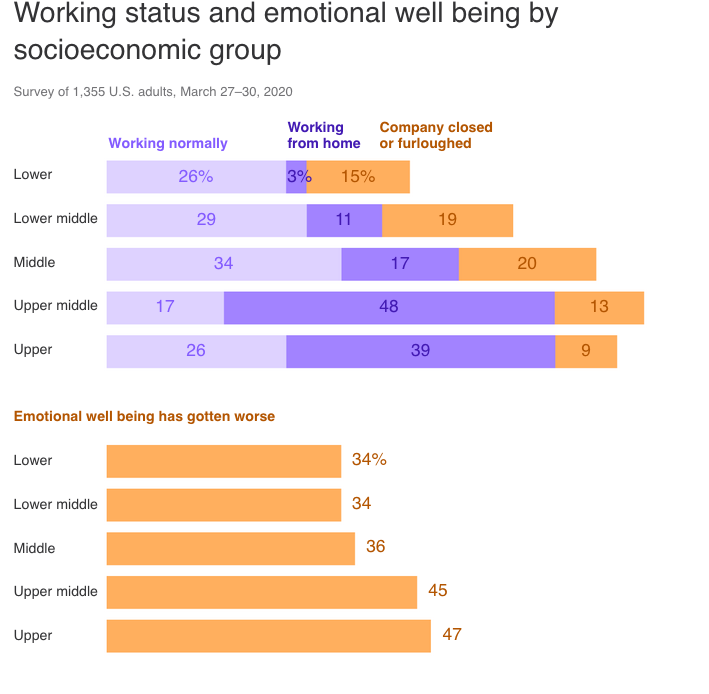
Driving the news: This sobering reality emerges from Week 3 of our Axios-Ipsos Coronavirus Index.
- The survey finds Americans with less education and lower incomes far more likely either to have to keep showing up at their workplaces — putting themselves at greater daily risk of infection — or more likely to have seen their work dry up.
- "The rich and affluent have gone virtual. They've maintained their jobs through the virtual world," he said. "The working and the poor are more exposed."
- 47% of respondents designated as coming from the upper socioeconomic status and 45% of those from the upper-middle status said their emotional well-being declined. That was the case for just 34% of the lower and lower-middle groups and 36% of the middle group.
- Concerns about job security and ability to pay the bills are tied to socioeconomic level.
- There are also correlations across the survey respondents' race, ethnicity, age, region of the country and whether they live in urban or non-urban settings. But the driving factor appears to be socioeconomic status.
By the numbers: Pollster Chris Jackson analyzed the findings by five groups of socioeconomic status:
- Lower (20%, high school education, $15,000 median household income)
- Lower middle (21%, high school education, $40,000 median household income)
- Middle (32%, some college, $75,000 median household income)
- Upper middle (20%, bachelor's degree, $125,000 median household income)
- Upper (8%, master's degree, $200,000 median household income)
- Just 3% of the lower-status group said they're working remotely or from home. That rose significantly with income, with nearly half of the upper-middle group, and nearly four out of 10 in the upper category, saying they're working remotely.
- About one in four out of the lower-status group, and slightly higher shares of the lower-middle and middle respondents, said they're going to work as they normally would.
- But 15% of the lower-status group, and roughly one in five of the lower-middle and middle groups had furloughs or their businesses closed. Those numbers dropped with the upper middle and upper groups.
- 45% of the lower group said they're extremely or very concerned about their job security as a result of the coronavirus — compared to just 21% of the middle group and 13% of the upper group.
- About a third of the lower group and one in four of the lower middle group said they're extremely or very concerned about their ability to pay the bills — significantly higher than the other groups.
- The margin of sampling error is +/- 2.8 percentage points at the 95% confidence level, for results based on the entire sample of adults.
- The margin of error for each of the five socioeconomic segments is higher because the sample sizes are smaller. They ranged from +/- 5 percentage points for the middle-status group to +/- 9 percentage points for the upper-status group.



Comment: While the wealthy will be insulated from the worst of the financial and emotional effects of this hysteria, the ensuing impact on the majority will be devastating. The PTB are preparing for the time when the masses finally realize that the panic and lockdown over the virus was completely unnecessary and are setting the stage to institute martial law - among other things. The question is - are there enough people who can see what is happening and have the strength and will to resist?